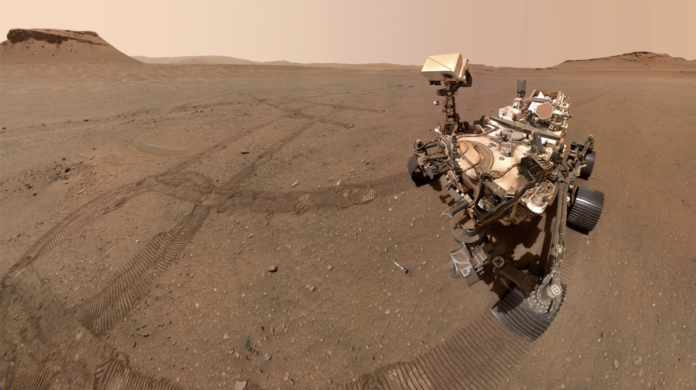NASA’s Perseverance Mars rover has finished building its backup sample depot on the Red Planet.
The car-sized Perseverance rover just stashed the last of the 10 sample tubes that comprise the depot. Word of the successful drop came in on Sunday night (Jan. 29), about six weeks after the rover deployed the first of the samples.
“It’s official: @NASAPersevere has dropped the final tube for the #MarsSampleReturn depot!” officials with NASA’s Jet Propulsion Laboratory (JPL) in Southern California, which manages Perseverance’s mission, said via Twitter on Monday (opens in new tab) (Jan. 30). “Ten samples have been deposited on the Martian surface and could be returned to Earth for in-depth analysis in the future.”
Related: Mars sample return mission adds 2 helicopters, scraps ‘fetch’ rover
Perseverance landed in February 2021 on the floor of the 28-mile-wide (45 kilometers) Jezero Crater, which harbored a big lake and a river delta billions of years ago.
The six-wheeled robot is hunting for signs of ancient Mars life and collecting dozens of samples, which will be returned to Earth by a joint NASA-European Space Agency (ESA) campaign as early as 2033, if all goes according to plan.
The baseline sample-return architecture calls for Perseverance to deliver several dozen samples to a rocket-equipped NASA lander on the Red Planet. That rocket will then send the samples to Mars orbit, where they’ll be snagged and hauled to Earth by an ESA probe. Perseverance is the only one of these spacecraft that’s currently operational; the ESA orbiter and NASA lander are scheduled to launch in 2027 and 2028, respectively.
Perseverance is in good condition now, but a lot can happen in five or six years. So the mission team came up with the depot as a backup plan, in case the rover isn’t able to deliver the samples itself. In the backup scenario, two small helicopters will collect the tubes from the depot, which is in a patch of Jezero the team calls Three Forks, and bring them back to the lander one by one.
These helicopters will launch aboard the lander in 2028. They’ll be based heavily on Ingenuity, the 4-pound (1.8 kilograms) chopper that launched with Perseverance as a technology demonstration and is still going strong after 40 flights on the Red Planet.
The Three Forks samples, by the way, are doubles; each one has a twin that Perseverance is carrying on its body.
Perseverance deposited the 10 tubes at the Three Forks depot in a zigzag pattern, placing each one 15 to 50 feet (5 to 15 meters) from its nearest neighbor to allow for easier helicopter recovery.
“Adding time to the depot-creation process, the team needed to precisely map the location of each 7-inch-long (18.6-centimeter-long) tube and glove (adapter) combination so that the samples could be found even if covered with dust,” JPL officials wrote in an update on Monday (opens in new tab). “The depot is on flat ground near the base of the raised, fan-shaped ancient river delta that formed long ago when a river flowed into a lake there.”
Now that its depot work is done, Perseverance will head up the ancient delta, examining the intriguing rocks as it goes. After the rover passes an outcrop the team calls Rocky Top, it will be in position to begin a new phase of its science mission called the Delta Top Campaign.
“We found that from the base of the delta up to the level where Rocky Top is located, the rocks appear to have been deposited in a lake environment,” Perseverance Project Scientist Ken Farley, of the California Institute of Technology in Pasadena, said in Monday’s update.
“And those just above Rocky Top appear to have been created in or at the end of a Martian river flowing into the lake,” Farley said. “As we ascend the delta into a river setting, we expect to move into rocks that are composed of larger grains — from sand to large boulders. Those materials likely originated in rocks outside of Jezero, eroded and then washed into the crater.”
The Delta Top Campaign is expected to last about eight months, mission team members have said.
Mike Wall is the author of “Out There (opens in new tab)” (Grand Central Publishing, 2018; illustrated by Karl Tate), a book about the search for alien life. Follow him on Twitter @michaeldwall (opens in new tab). Follow us on Twitter @Spacedotcom (opens in new tab) and on Facebook (opens in new tab).

